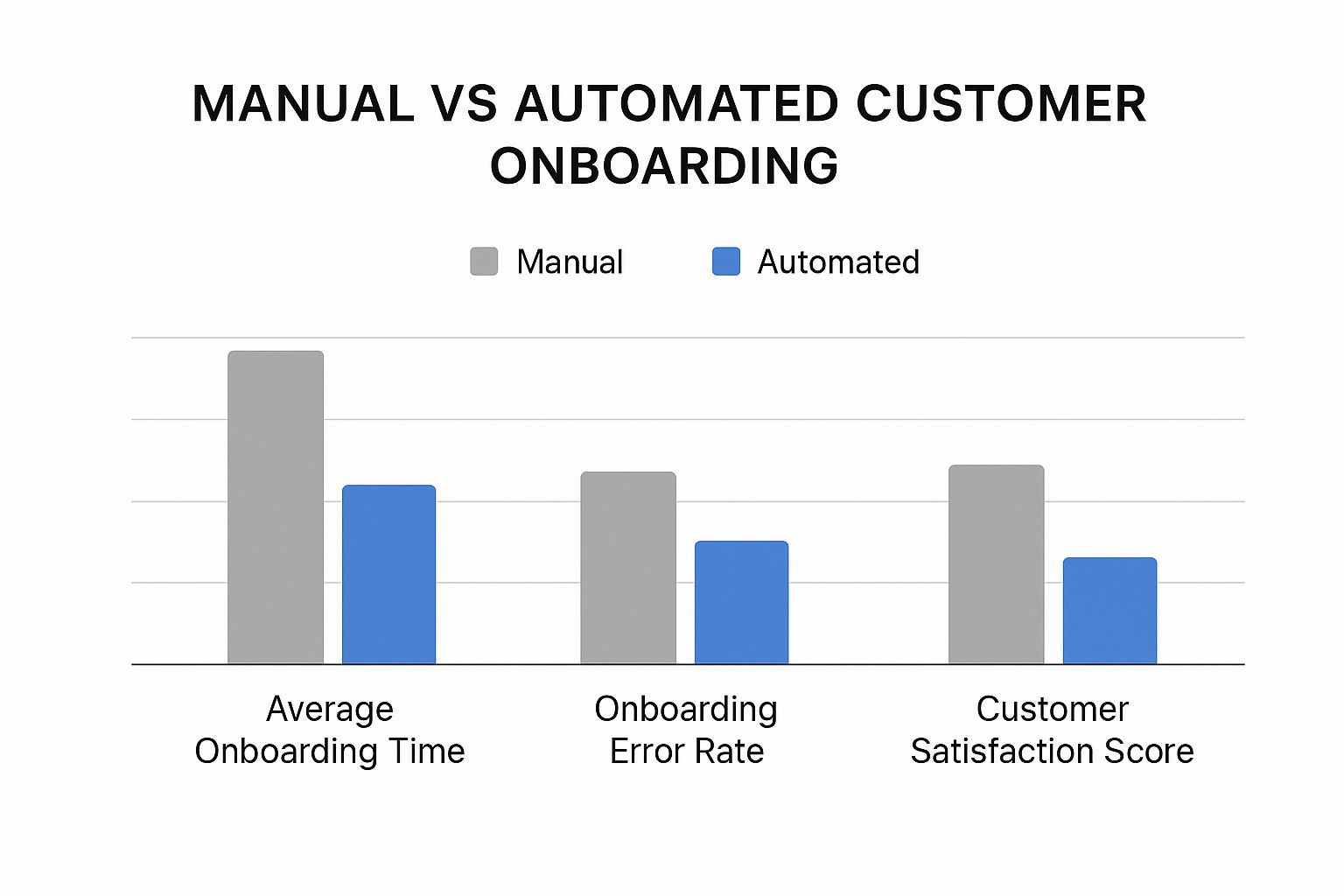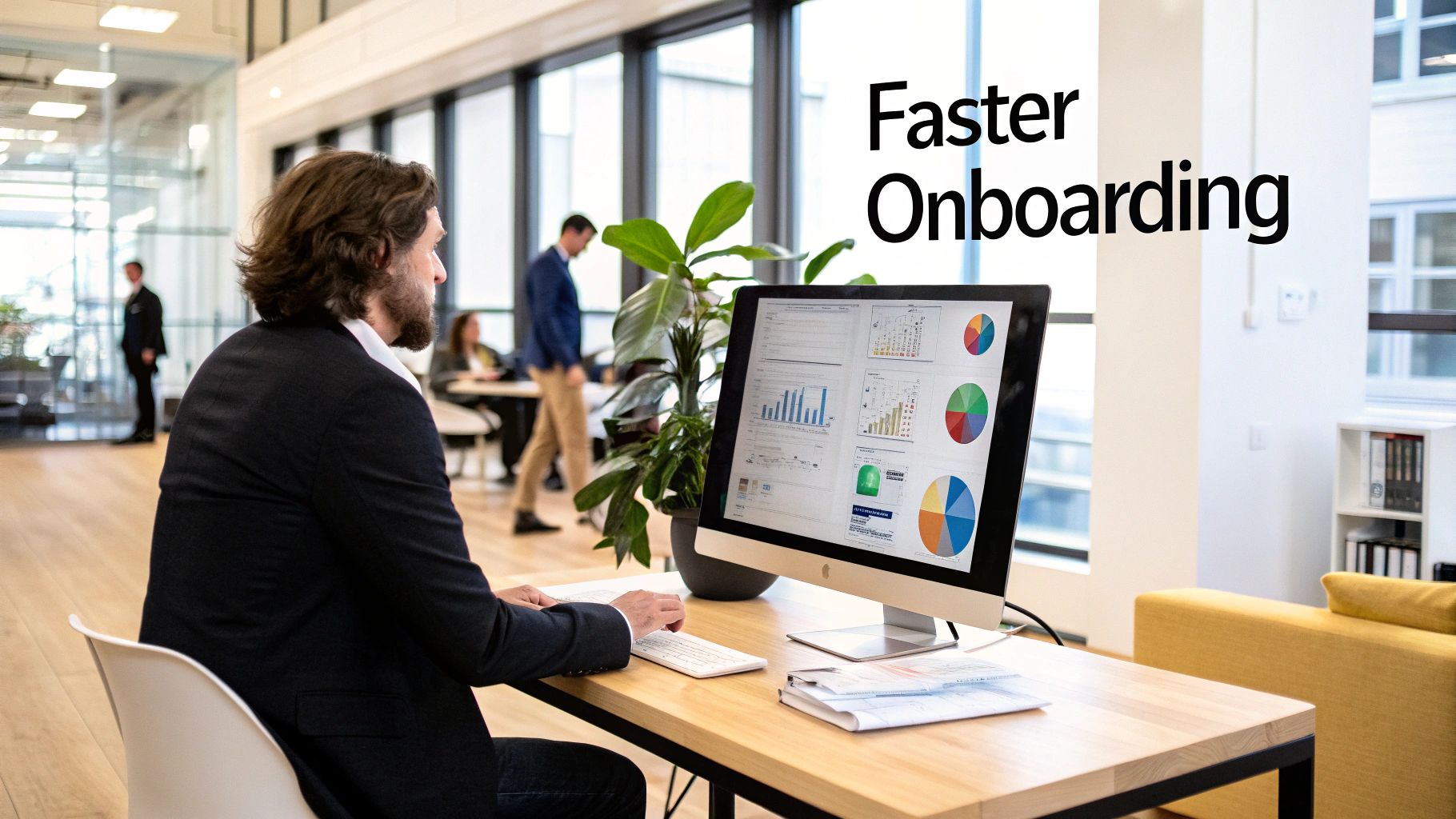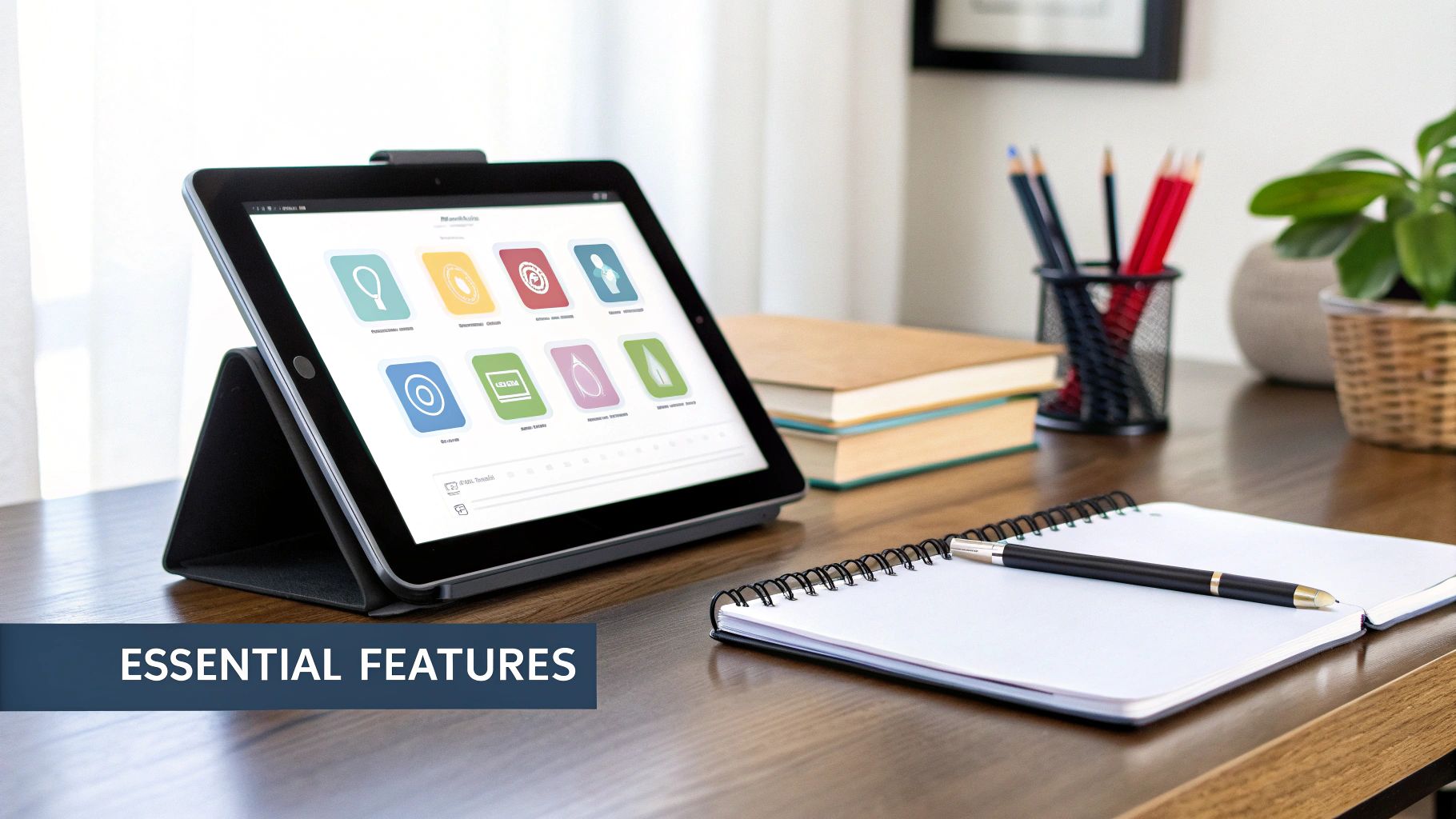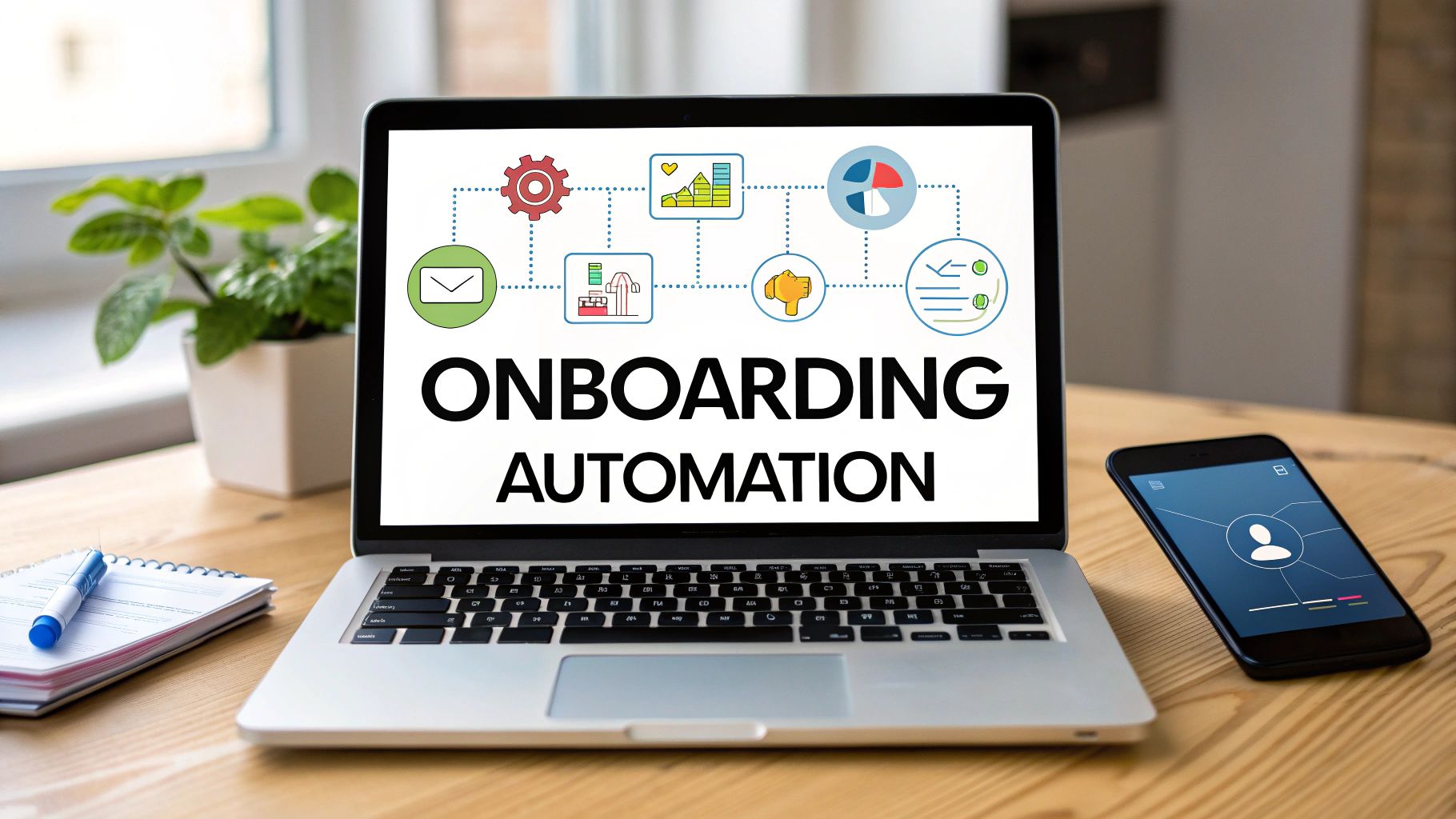That first purchase feels like a win, doesn't it? But if we're being honest, the real work starts the moment that confirmation email lands. From our experience with over 500 Shopify stores, that post-purchase silence is where churn quietly takes root and customer lifetime value (LTV) starts to wither away. You’re fighting low margins and endless competition; you can't afford to treat customers like one-time transactions.
This playbook will give you the exact strategies we use to fix that. You'll learn how to implement customer onboarding automation that turns first-time buyers into loyal fans, all on the one channel they actually check: WhatsApp.
Your Silent Growth Engine: The Power of Automated Onboarding
Let’s get straight to the point. Customer onboarding automation is the system you build to guide a first-time buyer into becoming a loyal, repeat customer. It's much more than a simple 'thank you' message; it's a carefully planned series of conversations that kick off automatically after a purchase.
Think of it as your most dedicated employee, working 24/7 to deliver a perfect, personalized experience every single time. This system becomes your brand ambassador, building trust, showing customers how to get the most out of their new product, and setting the stage for their next purchase before they've even considered it.
In the trenches of e-commerce, where margins are tight and competition is relentless, keeping a customer is far more profitable than finding a new one. This is precisely where automation becomes your silent growth engine. Instead of manually tracking orders and sending one-off emails that get buried in crowded inboxes, you create a repeatable, scalable process that just works.
The difference between a manual, hands-on approach and a smart, automated one is night and day.

The numbers don't lie. Automation drastically cuts down onboarding time and virtually eliminates errors, all while giving customer satisfaction a major boost. That's a powerful combination for any growing business.
Why This Is Your Most Valuable Opportunity
A common mistake we see is brands pouring all their energy into getting that first sale, only to go completely silent afterward. That post-purchase window is your golden opportunity to make a lasting impression. A well-executed onboarding flow reassures the customer they made the right choice and shows you care about their experience, not just their money.
By 2025, customer onboarding automation is set to completely change how businesses welcome new clients, thanks to big steps forward in AI and data analytics. Companies that get on board with this are already seeing huge wins, including a 26.4% reduction in customer churn and major improvements in efficiency. It's a serious competitive edge.
This process builds what we call "relationship equity." It’s the trust and goodwill you bank with a customer that makes them think of you first next time they need something. To get a better feel for the "silent growth engine" power of automated onboarding, looking at some advanced marketing automation workflow examples can give you some fantastic ideas for your own strategy.
Manual vs Automated Onboarding: A Clear Comparison
To really understand the impact, let's break down the practical differences between a traditional, manual onboarding process and a modern, automated approach.
AspectManual OnboardingAutomated Onboarding with KanalSpeedSlow and delayed; dependent on employee availability.Instant and 24/7; messages are sent immediately after a purchase.ConsistencyInconsistent; quality and tone vary by employee and workload.Perfectly consistent; every customer gets the same high-quality brand experience.ScalabilityDifficult to scale; requires hiring more people to handle growth.Infinitely scalable; handles 10 or 10,000 customers without extra effort.PersonalizationLimited; generic messages are often used to save time.Highly personalized; uses customer data (name, product purchased) for tailored messages.Error RateHigh; prone to human error like typos or sending the wrong info.Near-zero; workflows are pre-tested and run flawlessly every time.CostHigh labor costs; paying staff for repetitive, time-consuming tasks.Low operational cost; a small subscription fee automates the work of multiple people.
The takeaway is clear: automation isn't just about efficiency; it's about delivering a superior customer experience that manual processes simply can't match.
The goal isn't just to inform, but to delight. An effective customer onboarding automation strategy should:
- Build Immediate Trust: Confirm the order and send proactive shipping updates right away. No more "Where is my order?" emails.
- Educate and Add Value: Share tips on how to use the product, link to setup guides, or provide styling inspiration. Help them win.
- Open a Dialogue: Encourage feedback and make it incredibly easy for customers to ask questions on a channel they actually check constantly, like WhatsApp.
- Drive the Next Action: Strategically introduce complementary products or invite them to a loyalty program when the time is right.
Why WhatsApp Is Your Ultimate Onboarding Channel
Let's be honest. You're probably using email for customer onboarding. It’s the default, the old standby. But if we're really being honest, are those beautifully designed emails you're sending actually getting opened? Or are they just getting lost in a sea of promotions and spam? With average email open rates hovering around a measly 20%, you could be pouring all that effort into an empty room.
From our experience with hundreds of Shopify stores, this is the single biggest stumbling block in most onboarding strategies. Your message can be perfect, but if nobody sees it, it might as well not exist. This is exactly why we, as an official Meta Business Partner, built Kanal to harness the power of WhatsApp for these critical customer conversations.

The data is crystal clear. WhatsApp isn't just another messaging app; it represents a completely different way of communicating with your customers.
The numbers don't lie. While you're lucky to get one in five people to open an email, WhatsApp delivers a mind-blowing 98% open rate. No, that’s not a typo. Almost every single message you send gets seen.
This fact alone fundamentally changes the entire dynamic of customer onboarding automation. You stop broadcasting one-way announcements into the digital void and start having genuine, two-way conversations on a platform your customers already use every day to chat with their friends and family.
Creating a VIP Experience
Think about it. When a brand emails you, it feels impersonal, like a mass message sent to thousands. Now, picture getting a personal WhatsApp message right after you make a purchase. It feels direct, exclusive, and important. It feels like a VIP service.
That personal touch is the real magic of using WhatsApp for onboarding. Here’s what it looks like in practice:
- Instant Gratification: You can immediately confirm their order and send tracking details, wiping out that common "where's my stuff?" anxiety.
- Real-Time Interaction: If a customer has a question, they can simply reply to your automated message and get an instant answer, whether from a chatbot or a live agent.
- Rich Media Engagement: Why stick to text? Send a quick video tutorial on how to use their new product, a fun GIF celebrating their purchase, or a handy PDF setup guide.
Suddenly, a purely transactional moment transforms into a real conversation. It's the difference between a brand that talks at you and one that talks with you. Your logo design also plays a critical role in this communication, making the brand feel familiar and trustworthy.
Gathering Feedback and Building Loyalty
One of the most valuable—and often overlooked—parts of WhatsApp onboarding is gathering feedback effortlessly. Imagine an automated message going out a week after delivery that says, "Hey [FirstName], how are you enjoying your new [ProductName]?"
Because it’s a simple, conversational message on a platform they trust, we've seen clients get response rates that are 5-10x higher than they ever did with traditional email surveys. This feedback is pure gold. It helps you spot product flaws, collect glowing testimonials, and make your customers feel genuinely valued.
This is how you build real loyalty. You're showing that you care about their experience long after their payment has gone through. By tapping into the full potential of the WhatsApp Business Platform, you’re not just automating messages; you're automating relationship-building at scale. And getting started is easier than you might think; our guide to WhatsApp integration for e-commerce walks you through the initial steps.
With Kanal, setting up these powerful automated flows is incredibly straightforward. You can design your entire onboarding journey in minutes, using proven templates to guide customers from their first purchase to their next, all inside the app they already have open on their phone.
The 5 Essential Onboarding Flows for E-Commerce
Theory is great, but let's be honest—it's the practical, hands-on strategies that actually grow your business. Enough with the high-level talk about customer onboarding automation. Let's get our hands dirty and build the exact messaging flows that turn a first-time buyer into a lifelong fan.
After working with over 500 Shopify stores, we've zeroed in on five specific automations that consistently deliver the biggest bang for your buck. These aren't just generic templates; they're battle-tested blueprints. They build trust, teach customers about their new products, and drive that crucial second purchase—all on WhatsApp, where you have their undivided attention.
Let’s walk through the five flows your e-commerce brand needs to implement right away.
Flow 1: The Welcome Series
The moment a customer clicks "buy" is your golden opportunity. Their excitement is at its peak, and a well-timed, human message can lock in that good feeling and build immediate trust. This is exactly what the welcome flow is for.
Instead of radio silence that can lead to buyer's remorse, you deliver instant delight. It’s a simple way to reassure them that they made a great decision.
How to build it:
- Trigger: Fire this off the second a new customer places their first order.
- Message 1 (Instant): Send a personalized order confirmation that feels more like a high-five than a receipt. Ditch the robotic "Order #1234 confirmed."
- Example: "Hey [FirstName]! 👋 Your [BrandName] order is in! We're so excited for you to get your [ProductName]. We'll ping you again as soon as it ships. - [Your Name] from [BrandName]"
- Message 2 (When Shipped): Follow up with a shipping notification and tracking link. This one message will slash the number of "Where is my order?" tickets you get.
- Example: "Great news, [FirstName]! Your order has shipped! 🚀 You can follow its journey right to your door here: [TrackingLink]. Can't wait for you to get it!"
Flow 2: Product Education and Usage Tips
So, the package has arrived. Now what? Never assume your customers intuitively know how to get the most from their purchase. An educated customer is a happy customer, and a happy customer comes back for more.
A huge mistake we see brands make is leaving this critical step to chance. By proactively showing them how to use, style, or care for their item, you add a ton of value and position your brand as a helpful expert, not just a retailer.
This flow helps customers get the results they were hoping for, which boosts their satisfaction and drastically cuts down on returns from people who simply "couldn't figure it out."
How to build it:
- Trigger: Set this for 2-3 days after the order is marked as delivered.
- Personalize by Product: This is key. A tip for a skincare product is useless to someone who bought a jacket. Segment your messages based on the product or category they purchased.
- Message: Send a short, value-packed tip. A quick video or a sharp image works wonders here.
- For a skincare product: "Hi [FirstName]! ✨ Hope you're loving your new serum. Pro tip: For the best results, apply it to slightly damp skin right after cleansing to really lock in that moisture. Let us know if you have any questions!"
- For a fashion item: "Hey [FirstName]! Wondering how to style your new jacket? Here’s a quick lookbook we put together for some inspiration: [LinkToStyleGuide]. We'd love to see your look! #OurBrand"
Flow 3: First-Time Purchase Feedback
You can't fix what you don't know is broken. Asking for feedback isn't just about being polite; it's about gathering priceless intel to make your products and your entire customer journey better. But let's face it, long-winded email surveys have terrible open rates.
A simple, conversational request on WhatsApp feels way more natural and, as a result, gets much higher response rates. In fact, we've seen clients boost their review collection by over 300% with just this one flow.
How to build it:
- Trigger: Wait 7-10 days after delivery. This gives them enough time to actually use the product.
- Message: Keep it short and sweet. Ask one simple question.
- Example: "Hey [FirstName], it's [Your Name] from [BrandName] again. We're always trying to get better and would love to know—how are you finding your [ProductName]? A quick reply with your thoughts would mean the world to us!"
- Follow-up (Optional): If they reply with positive feedback, that's your cue! Follow up with a direct link to leave a formal review on your site.
Flow 4: Smart Cross-Selling and Upselling
Once you’ve delivered a great experience, you’ve earned the right to suggest what’s next. The trick is to make it a helpful recommendation, not a sleazy sales pitch. Look at what they bought and offer something that truly complements it. This is a core feature that the best WhatsApp apps for Shopify should handle with ease.
This works because it’s timely, relevant, and personal. You’re not just blasting them with random promotions; you’re saying, "Hey, since you loved Product X, we have a feeling you’ll get a lot out of Product Y." This approach is a proven way to increase both Average Order Value (AOV) and customer lifetime value.
With a tool like the Kanal flow builder, setting up these kinds of intelligent, personalized automations is surprisingly straightforward.

The visual editor lets you map out powerful flows that respond to what your customers actually do, all without needing to write a single line of code.
How to build it:
- Trigger: 14-21 days after their first purchase is a good window.
- Message: Make a specific, data-backed recommendation. Sometimes a small incentive can seal the deal.
- For coffee beans: "Hi [FirstName]! Hope your coffee game is going strong. We noticed you bought our Espresso Blend. A lot of our customers find it pairs perfectly with our new electric milk frother for café-style lattes at home. Want to take a look? ☕"
Flow 5: The Loyalty Program Invitation
Your most engaged new customers—the ones opening your messages and leaving reviews—are perfect candidates for your loyalty program. Don't just hope they stumble upon it on your website. Personally invite them. Make them feel like they're being welcomed into an exclusive club.
This simple gesture makes customers feel valued and gives them a powerful reason to shop with you again instead of a competitor. After all, loyalty program members spend, on average, 67% more than other customers.
How to build it:
- Trigger: Send this after a customer does something positive, like leaving a great review or clicking on your educational content.
- Message: Frame it as a special invitation. Be very clear about the top benefit, like earning points or getting free shipping.
- Example: "Hey [FirstName], because you're one of our awesome new customers, we wanted to personally invite you to our VIP Club! You'll earn points on every purchase and get early access to new drops. It’s free to join! Sound good?"
A fantastic onboarding experience shouldn't just fizzle out after the first week. We’ve seen countless brands absolutely nail their welcome messages and product education, only to go completely silent afterward. But real customer onboarding automation isn't a one-time thing; it's an ongoing cycle built to nurture that customer relationship for the long haul.
The goal here is to maximize what's known as Lifetime Value (LTV). Simply put, LTV is the total revenue you can reasonably expect from a single customer over their entire time with your brand. A single purchase is great, but getting that person to come back for a second, third, and fourth purchase is how you build a seriously profitable business. An ongoing strategy turns onboarding from a short-term welcome mat into a long-term loyalty engine.
Personalize at Scale with Advanced Segmentation
So, what's the secret to effective long-term onboarding? It's moving past generic, one-size-fits-all messages. The key is segmentation—the practice of grouping your customers based on their specific behaviors so you can send them content that actually resonates.
With Kanal, you can create powerful customer segments using your Shopify data. Think about it:
- Purchase History: Group customers who bought a specific product. Someone who just purchased a beginner's yoga mat needs very different advice than the person who bought an advanced kettlebell.
- Customer Value: Create special segments for your top spenders (your VIPs) or your most frequent buyers. These are the people who deserve some extra love.
- Engagement Level: You can even segment users based on whether they've clicked links in your past messages. This lets you re-engage the quiet ones with a tempting offer to bring them back into the fold.
Once you have these segments, you can build automated check-ins and support messages that feel incredibly personal, not robotic.
Automate Proactive Support and Check-ins
One of the biggest mistakes we see is brands waiting for a customer to report a problem before they offer help. A truly great long-term strategy anticipates needs before they even arise.
Imagine a customer buys a high-end espresso machine from your store. Instead of just sending a "thanks for your order" message, you could set up a long-term automated flow:
- Day 7: "Hey [FirstName], how's the new espresso machine treating you? Have you tried pulling your first shot yet? Here's a 1-minute video on getting the perfect crema: [LinkToVideo]"
- Day 30: "Hi [FirstName]! Quick check-in from [BrandName]. Your machine might be due for a quick cleaning cycle to keep it running perfectly. Here's a guide: [LinkToGuide]"
- Day 90: "Looks like you've had your machine for about 3 months, [FirstName]! You might be running low on our House Blend beans. Here's 15% off your next bag as a thank you: [DiscountCode]"
This isn't just marketing; it's genuine, helpful service. You’re turning a simple transaction into a supportive, consultative relationship—all on autopilot. This is where the future of customer success is heading; as recent trends show, integrating your onboarding and marketing automation is crucial for boosting satisfaction and keeping customers around.
Create an Exclusive Community for Your Best Customers
Your most loyal customers want to feel like insiders. One of the most powerful strategies we've helped clients implement is creating an exclusive "VIP Club" on WhatsApp for their top-spending or most engaged fans.
Real-World Example: We work with a sustainable fashion brand that used Kanal to create a "VIP Style Council" segment. These customers get early access to new collections, exclusive discounts, and a direct line to the brand's stylists for advice. The result? They increased their repeat purchase rate by 35% in just six months from this group alone.
You can automate invitations to this community based on triggers, like when a customer makes their third purchase or their total spending crosses the $500 mark. It’s a simple way to make your best customers feel seen and rewarded, which in turn transforms them into passionate brand advocates. These advanced, multi-step journeys are surprisingly easy to build, and we've put together some proven sequences in our library of e-commerce playbooks that you can adapt for your own store.
By thinking beyond the first week, you shift customer onboarding automation from a simple cost-saver into a powerful, long-term revenue driver.
Common Onboarding Mistakes and How to Fix Them
After working with over 500 Shopify stores, we've seen the same onboarding mistakes trip up even the smartest founders. Getting your customer onboarding automation right isn't about mastering some complex technology; it’s really about sidestepping a few common-sense pitfalls.
Consider this your cheat sheet for getting it right from the start.

Let's break down the most frequent missteps we see and, more importantly, the simple fixes you can implement today. The goal is to build an onboarding flow that feels genuinely helpful and human, not robotic or spammy.
Mistake 1: Sending Too Many Messages (or Too Few)
Finding the right message frequency is a classic Goldilocks problem. Bombarding a new customer with five messages in three days feels desperate and intrusive, which is an instant turn-off. On the flip side, sending a single order confirmation and then disappearing for a month is a massive missed opportunity to build a relationship.
The Fix: Find Your Goldilocks Cadence
The strategy that consistently delivers the best results for our clients is to focus on value, not volume. Every single message needs a clear purpose.
Here's a great starting point for any new customer:
- Message 1 (Instant): The order confirmation. This immediately reassures them their purchase went through.
- Message 2 (On Shipment): The shipping notification. This manages their excitement and expectations.
- Message 3 (2-3 Days Post-Delivery): A quick product tip or educational piece. This adds value beyond the transaction.
- Message 4 (7-10 Days Post-Delivery): A simple feedback request. This shows you care about their experience.
This four-message sequence covers the initial journey beautifully without ever feeling overwhelming.
Mistake 2: Using a Robotic and Impersonal Tone
Just because a message is automated doesn't mean it has to sound like it was written by a robot. Customers on WhatsApp expect a conversation, not a corporate press release. A cold, formal tone can absolutely kill any chance you have of building a real connection.
We’ve tested this across hundreds of campaigns: flows that use a friendly, casual tone consistently get 2-3x higher engagement rates and more positive replies than overly formal ones.
The Fix: Write Like You're Talking to a Friend
This is probably the easiest fix with the biggest impact. Here’s how you do it:
- Use Their Name: Always use personalization tags like
[FirstName]. It’s a small detail that makes a huge difference. - Embrace Emojis: A well-placed emoji (like 👋, ✨, or 🚀) instantly makes your brand feel more approachable and modern.
- Sign Off with a Name: Ending a message with "- Sarah from [BrandName]" feels infinitely more personal than just your logo.
Mistake 3: Forgetting the Human Handoff
Automation is incredibly powerful, but it’s not meant to be a fortress. One of the biggest frustrations for any customer is getting stuck in an automated loop with no clear way to reach a real person. This can quickly turn a minor question into a major problem.
The Fix: Always Provide an Escape Hatch
Your automation should always have a clear path to human support. In every other message, simply add a line like, "Just reply to this message if you have any questions!"
Then, you can use a tool like Kanal to set up keyword triggers (e.g., "help," "question," "agent") that automatically pause the automation and notify your support team. This gives you the best of both worlds: the efficiency of automation and the invaluable touch of human support when it matters most.
Onboarding Strategy Do's and Don'ts
To help you put all this together, here’s a quick checklist you can use to audit your current strategy. It’s a simple way to spot common pitfalls and ensure you’re following best practices.
DoDon'tPersonalize Every MessageUse generic, one-size-fits-all copy.Focus on Value, Not VolumeBombard users with too many messages at once.Maintain a Consistent Brand VoiceSound formal and robotic.Provide a Clear Path to Human SupportTrap customers in an endless automated loop.Test and Refine Your CadenceAssume your first attempt is perfect.Use Emojis and Casual LanguageWrite like you're drafting a legal document.
Think of this table as your go-to reference. By sticking to the "Do's" and steering clear of the "Don'ts," you'll be well on your way to creating an onboarding experience that customers actually love.
How to Measure Your Onboarding ROI
You can't improve what you don't measure. In e-commerce, every decision needs to be backed by data, and your customer onboarding automation strategy is no different. From what we've seen, the brands that truly succeed are the ones that obsessively track performance and are always on the lookout for ways to get better.
So, how do you actually prove your WhatsApp onboarding flows are making you money? It means looking past surface-level stats and zeroing in on the Key Performance Indicators (KPIs) that hit your bottom line.
Connecting Onboarding to Core Business Metrics
Your onboarding efforts don't happen in a silo; they directly impact your store's most critical financial numbers. The real goal is to draw a straight line from your automated WhatsApp messages to tangible business growth.
Here are the main KPIs you absolutely have to track:
- Repeat Purchase Rate: This is the big one. What percentage of new customers come back to buy a second time? A great onboarding flow builds the trust and excitement that gets them to return. We've seen clients increase this metric by over 20% with a solid WhatsApp flow.
- Customer Lifetime Value (LTV): This metric tells you how much a customer is worth to your brand over their entire relationship with you. Solid onboarding is the very first step in maximizing LTV, turning one-time buyers into long-term fans. You can get a clearer picture of this with our free customer lifetime value calculator.
- Churn Reduction: Churn is the silent killer of growth. While it's a huge topic in SaaS, the idea is just as vital for e-commerce. The SaaS industry sees average churn rates of 5% to 7%, and the best companies use automation to fight it. Good onboarding reassures new buyers, making it less likely they'll purchase once and then vanish. You can dive deeper into how SaaS businesses leverage onboarding statistics to keep customers around.
Tracking Engagement Within Your WhatsApp Flows
Beyond those big-picture business metrics, you need to know what’s happening inside your message flows. This is where you'll spot opportunities to refine your copy, adjust your timing, and perfect your offers for even better results.
The Kanal dashboard gives you a crystal-clear view of your campaign performance.
Here, you can instantly see crucial metrics like open rates, click-through rates, and, most importantly, the revenue generated directly from your WhatsApp automations.
Inside your Kanal analytics, keep a close eye on these specific engagement metrics for each flow:
- Click-Through Rate (CTR): What percentage of customers are actually clicking the links you send, whether it's a tracking link, a product guide, or a cross-sell offer? A low CTR could signal that your offer isn't compelling or your call-to-action isn't clear enough.
- Reply Rate: Are customers actually responding when you ask for feedback or ask a question? A high reply rate is a fantastic sign that your tone feels human and your customers are comfortable talking back.
- Conversion Rate: For the customers who get a cross-sell or upsell message, how many of them follow through and make that purchase? This is the ultimate test of whether your offer is relevant and well-timed.
When you connect these on-the-ground engagement numbers back to your core business KPIs, you build an undeniable case for your customer onboarding automation and prove a clear, powerful ROI.
Frequently Asked Questions
Got questions about automating your customer onboarding with WhatsApp? We get it. Here are some of the most common things people ask us before they get started.
What's the Real Cost of Sending Onboarding Messages on WhatsApp?
Since Kanal is an official Meta Business Partner, we use the WhatsApp Business Platform. Meta has a simple, per-conversation pricing model that changes slightly depending on the country.
But here’s the best part: your first 1,000 conversations every single month are on the house—completely free. In our experience, the return you get from happier customers who stick around longer and buy more easily covers this small fee.
Will I Sound Like a Robot if I Automate This?
That’s a big concern for many brands, and a valid one. Nobody wants to sound like a machine. We built the Kanal flow builder specifically to avoid this. You can easily add personalization tags (like [FirstName] or [ProductName]), sprinkle in some emojis, and write your messages in a natural, conversational tone.
We also highly recommend using keyword triggers. For example, you can set up a rule so if a customer ever replies with words like "help" or "question," the automated flow pauses instantly, and a real person on your team gets a notification. This way, a human touch is always there when it's needed most.
How Long Will It Take to Get My First Onboarding Flow Running?
Honestly? You can have a core flow, like your welcome series, up and running in under 15 minutes.
We have a library of pre-built templates ready to go. All you have to do is pop in your own branding, your unique voice, and any special offers you have. We designed Kanal for busy e-commerce owners, not developers, so you can get going without any technical headaches.
Is This Kind of Automation Just for Big-Name Brands?
Absolutely not. In fact, we see automation as the ultimate equalizer. It allows smaller, growing brands to offer the same kind of instant, personal, and helpful communication that used to require a massive support team.
It’s a strategy that scales with you. You can start small and build from there, saving you precious time and boosting revenue from the very first day.
—
You now have the playbook. The key is to stop thinking in terms of one-time sales and start building relationships. With a solid customer onboarding automation strategy on WhatsApp, you can build trust, add value, and drive repeat purchases on autopilot.
Ready to build your own high-converting flows? Install Kanal on your Shopify store today or schedule a demo to see it in action.



